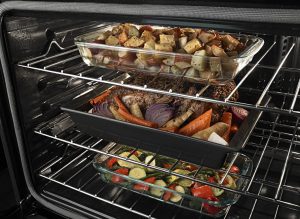Incorrect Oven Temperature
When your oven is preheated, it should maintain the set temperature. If your food seems to be frequently overcooked or the readout displays a higher temperature than you’ve set, your temperature controls may need to be recalibrated. While this may seem daunting, the process of how you can calibrate your oven is usually detailed in the owner’s manual. This should provide instructions on how you can decrease or increase the oven temperature by up to 35 degrees. Typically, this involves pressing and holding certain buttons on the control pad, but this will vary according to the manufacturer and model.
The Oven Won’t Switch On
All your major kitchen appliances including your oven, dishwasher, and refrigerator should have their own circuit to prevent breakers from tripping. If your oven won’t switch on, the first stage of troubleshooting should be checking your junction box for any tripped circuit breakers. You will also need to check that the oven is plugged in.
If your appliance is receiving power, there could be a number of issues that are preventing it from switching on. Common issues include bad controls, broken wires, a damaged broil element or an incorrect amount of power supplied to the unit. Common problems for gas ovens include faulty igniters, valves or gas control. Since these issues will place you at risk of an electric shock, this troubleshooting should be left to an experienced professional.
No Oven Light
Trying to prepare a meal in the dark can be a challenge, so if the oven light is not working, you’ll need to determine why and correct the issue. Firstly, you should try replacing your bulb. If this doesn’t correct the problem, it could be that you have a faulty connecting wire, light switch or electronic control. There is a high risk of electric shock associated with any of these issues, so while no oven light may appear to be a minor issue, it is a good idea to leave this problem to an appliance repair technician.
The Oven Door Won’t Shut or Open
If your oven door won’t shut or open there could be a number of reasons for the problem. If you’ve just run a self-cleaning cycle and the door won’t open, try unplugging the appliance or shutting off the circuit breaker for approximately 5 minutes. Once power is restored, gently try the door lock lever and see if the door will now open. If you’re still having difficulties try resetting the self-cleaning cycle and allow it to run for 10 to 15 minutes and then cancel the cleaning cycle. Once the oven has cooled a little, try opening the door again.
If your oven door doesn’t shut, it could be a problem with the hinges. Replacing the hinges requires the door to be disassembled and you may even need to remove the side panel. Unless you are very confident with DIY, you should call in an appliance repair specialist.
Self-Cleaning Program Won’t Run
There are several common issues that can prevent your oven from self-cleaning. Firstly, you need to ensure that the door is properly locking shut, as most ovens have a safety feature that prevents the cycle from running if the door is not locked.
If this is not the cause of the issue, you may have a problem with the oven control board, thermal fuse, temperature control thermostat or wiring. It requires special tools and skills to test and repair all of these components, so you’ll need help from an appliance repair technician.
There are a number of oven repair problems you may encounter, but by educating yourself on the common issues, you may be prepared to tackle simple repair projects. For a more long-lasting and effective solution, you should call a professional home appliance repair technician.
For help with all your oven repair needs, ensure you speak to a professional appliance repair service.
